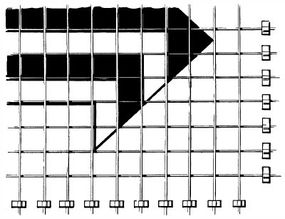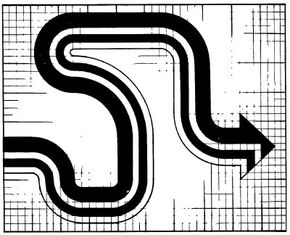How to Paint a Mural
Transform a plain room with a strong supergraphic; create your own indoor view with a full-wall mural. Either is easy to do with this simple grid system.
Tools:
- Pencil
- Measuring rule or tape measure
- Bucket and sponge
- Straightedge
- Paintbrushes
Materials:
- Graph paper
- Household detergent
- String
- Metal washers or small weights
- Masking tape
- Latex enamel paints
Time: 1 to 2 days or more, plus drying time
Advertisement
Designing the Mural
Choose any design you like for your graphic or mural -- arrows, arches, a rainbow, animals, trees, whatever. Draw the design accurately on a sheet of graph paper (four squares per inch is easiest to enlarge on a wall), or draw a grid (four squares per inch) directly onto the picture or print you want to duplicate.
Gauge the grid according to the size of the graphic or mural. For example, if your graph-paper design is 4 inches wide and 3 inches high, and you want it to be 8 feet wide on the wall, it will also be 6 feet high. The 4 × 3-inch pattern will have horizontal rows of 16 squares, and vertical rows of 12 squares. For 8 linear feet to contain 16 horizontal squares, each foot will have two squares, and each square must be 6 inches on a side. Determine the vertical measurement the same way. For both dimensions, the size of each square is determined by your graph-paper drawing and the size of the wall.
Preparing the Wall
Before transferring your design to the wall, prepare the wall surface. Wash it thoroughly with a household detergent to remove dirt, dust, and grease. Let the wall dry completely.
Transferring the Design
Determine exactly where on the wall you want the mural to be. Starting at the upper left-hand corner, make the guidelines for the horizontal squares on the wall. Tape one end of a piece of string at the upper left-hand corner, letting it hang. Tie a metal washer or other weight to the bottom of the string. When the line hangs plumb, tape the bottom end of the string. Measure 6 inches to the right of the string, at top and bottom, and tape the second vertical string the same way. Repeat to place 17 strings, each 6 inches apart, forming 16 vertical divisions.
To complete the squares, measure an even distance down from the ceiling to the upper left and upper right vertical lines of the grid to determine the top of the mural. Stretch and tape a horizontal string between these two points; tape this string at several points to keep it from sagging.
Once the top horizontal string has been placed accurately, measure down 6 inches on both ends to position the next line. Repeat to place 13 horizontal strings, forming 12 rows of squares.

With all grid lines taped to the wall, transfer your design to the wall. Use a pencil to lightly copy your pattern -- square by square -- onto the wall. When the entire design has been transferred, carefully remove the tape and the strings; peel the tape off carefully so you don't damage the wall. Then final-draw the design, rounding curves evenly and adding any missing parts.
Painting the Mural
Paint the graphic or mural with latex enamel paint, one color at a time. If the design has a background color, paint the background first. Let the paint dry for 24 hours before painting over the background color. Work color by color; wash your paintbrushes thoroughly between colors. Paint all solid areas first; then mix colors for highlighting or shading.
When the entire design is complete, let it dry thoroughly, for at least 24 hours. If desired, you can outline key areas in black; use a very fine brush to make hairline outlines. Be careful not to overdo this outlining.
Let the completed mural dry thoroughly before replacing furniture or drapes that touch it. Clean the wall surface very carefully, if necessary.
Next, make your living space plush and cozy by learning how to make decorator pillows.
